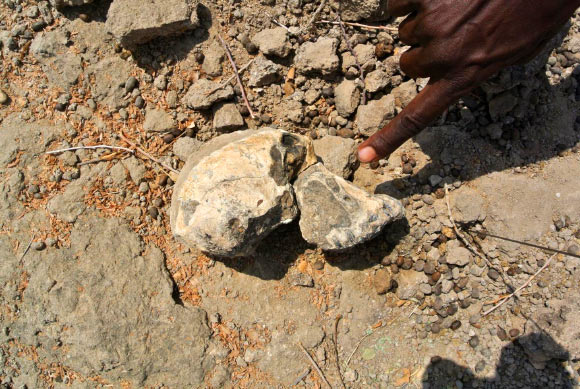Australopithecus anamensis is the earliest-known species in the genus Australopithecus. The species is widely accepted as the ancestor of Lucy’s species, Australopithecus afarensis, and was previously only known through teeth and jaw fragments, all dated to between 4.2 and 3.9 million years ago. Now, an international team of paleoanthropologists has discovered a well-preserved skull of Australopithecus anamensis in Ethiopia. Due to the skull’s rare near-complete state, the researchers identified never-before-seen facial features in this species. They also found that Australopithecus anamensis and A. afarensis coexisted for a period of at least 100,000 years, challenging previous assumptions of a linear transition between these hominins.

The 3.8-million-year-old skull of Australopithecus anamensis. Image credit: Yohannes Haile-Selassie, Cleveland Museum of Natural History.
The 3.8-million-year-old specimen, named MRD-VP-1/1 (MRD for short), was found at Miro Dora in the Godaya Valley of the northwestern Woranso-Mille area in 2016.
This locality is about 35 miles (56 km) away from Hadar, the region in which the famous Lucy specimen was found.
“Ethiopia has always been labeled as the cradle of humankind, especially in the Afar region, where we have 6 million years of our evolutionary history packed in this 3,280-foot (1 km) thick sediment,” said Dr. Yohannes Haile-Selassie, from the Cleveland Museum of Natural History.
In the years following this discovery, Dr. Haile-Selassie and colleagues conducted extensive analyses of MRD.
Among the most significant findings was their conclusion that Australopithecus anamensis and its descendant species coexisted for a period of at least 100,000 years.
This finding contradicts the long-held notion of anagenesis in hominins, whereby one species disappears and gives rise to the next in a linear fashion.
“This is a game changer in our understanding of human evolution during the Pliocene,” Dr. Haile-Selassie noted.

The facial reconstruction of MRD. Image credit: John Gurche / Susan & George Klein / Matt Crow / Cleveland Museum of Natural History.
Additionally, due to the cranium’s rare near-complete state, the scientists identified never-before-seen facial features in Australopithecus anamensis.
“MRD has a mix of primitive and derived facial and cranial features that I didn’t expect to see on a single individual,” Dr. Haile-Selassie said.
“Australopithecus anamensis was already a species that we knew quite a bit about, but this is the first cranium of the species ever discovered. It is good to finally be able to put a face to the name,” said Dr. Stephanie Melillo, from the Max Planck Institute for Evolutionary Anthropology.
“Some characteristics were shared with its descendant species, Australopithecus afarensis, while others differed significantly and had more in common with those of even older and more primitive early human ancestor groups, such as Ardipithecus and Sahelanthropus.”
MRD was found in the sandy deposits of a delta where a river entered a lake.
The river likely originated in the highlands of the Ethiopian plateau while the lake developed at lower elevations where rift activity caused the Earth surface to stretch and thin, creating the lowlands of the Afar region.
Fossil pollen grains and chemical remains of fossil plant and algae that are preserved in the lake and delta sediments provide clues about the ancient environmental conditions. Specifically they indicate that the watershed of the lake was mostly dry but that there were also forested areas on the shores of the delta or along the side the river that fed the delta and lake system.
“MRD lived near a large lake in a region that was dry,” said Dr. Naomi Levin, from the University of Michigan.
“We’re eager to conduct more work in these deposits to understand the environment of the MRD specimen, the relationship to climate change and how it affected human evolution, if at all.”
The results appear in two papers published August 28, 2019 in the journal Nature.
_____
Yohannes Haile-Selassie et al. A 3.8-million-year-old hominin cranium from Woranso-Mille, Ethiopia. Nature, published online August 28, 2019; doi: 10.1038/s41586-019-1513-8
Beverly Z. Saylor et al. Age and context of mid-Pliocene hominin cranium from Woranso-Mille, Ethiopia. Nature, published online August 28, 2019; doi: 10.1038/s41586-019-1514-7







